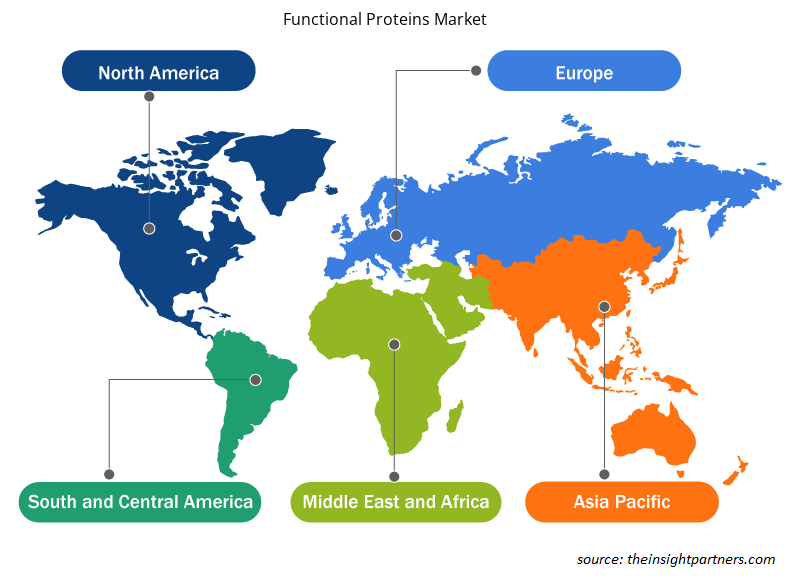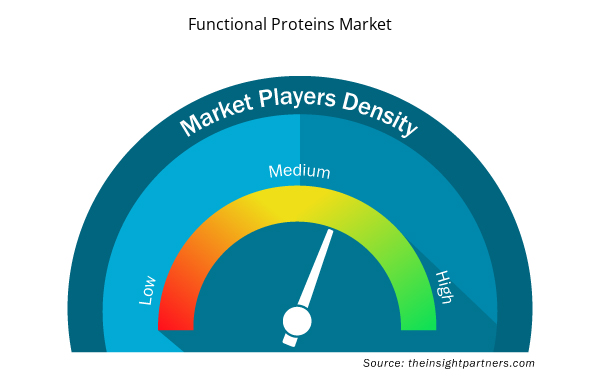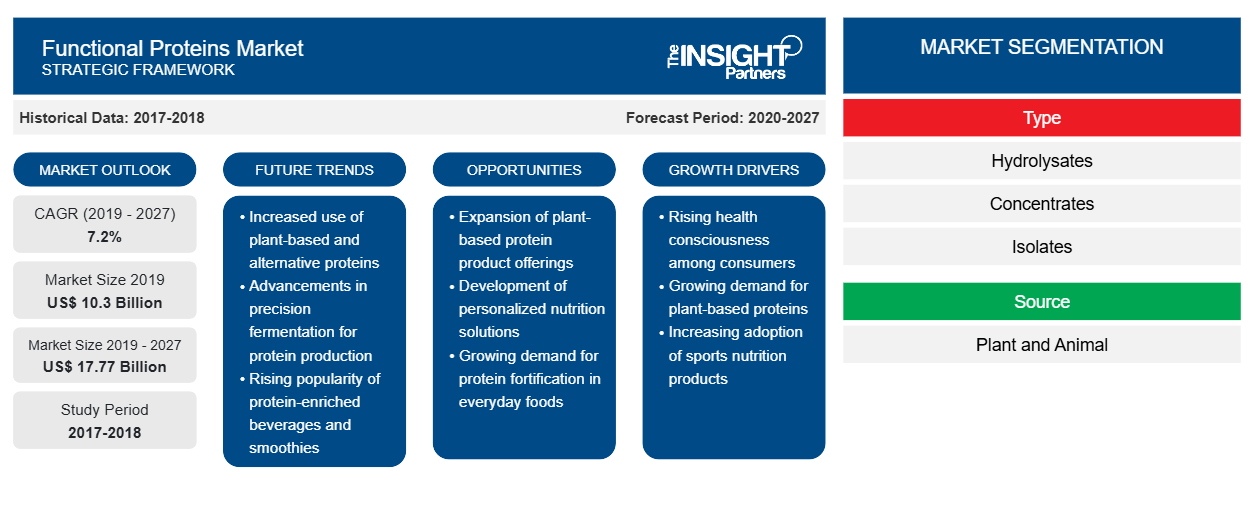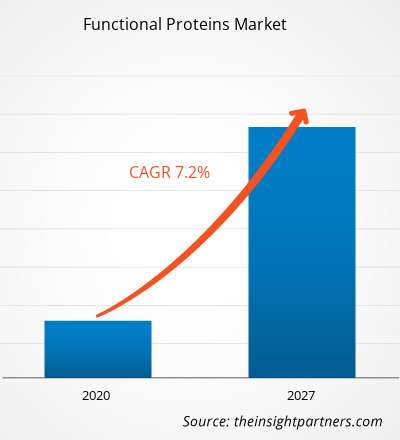[研究报告] 2019年功能性蛋白质市场价值为102.9791亿美元,预计到2027年将达到177.6748亿美元;预计2020年至2027年的复合年增长率为7.2%。
消费者更倾向于健康、保健和营养内容。食品行业不断推出新产品,考虑到消费者采用健康的生活方式。在功能性食品成分中,蛋白质是天然存在于各种动物和植物来源中的重要成分之一。蛋白质对于身体的平稳运作至关重要,是身体组织和器官的结构、功能和调节所必需的。消费者对功能性蛋白质带来的好处的认识对功能性蛋白质市场的增长做出了重大贡献。此外,亚太、中东、非洲和南美等新兴经济体消费者可支配收入的增加也促进了市场的增长。
2019 年,亚太地区占据了全球功能性蛋白质市场的最大份额。亚太地区的新兴国家正在经历中产阶级人口和城市化增长的激增,这为市场的主要市场参与者提供了丰厚的机会。由于人口基数增加和可支配收入增加,该地区在功能性蛋白质消费中占有很大份额。亚太地区功能性蛋白质市场的增长主要受到日益增强的医疗保健意识和消费者对营养和健康饮食日益增长的兴趣的推动。此外,亚太地区含有大量功能性蛋白质的婴儿配方奶粉的销量也在上升。亚太国家职业女性人口正在增加,许多职业母亲更喜欢为婴儿选择健康方便的食品,这也促进了市场的增长。
2019 年 12 月,武汉首次报告了 COVID-19 疫情。截至 2021 年 2 月,美国、印度、巴西、俄罗斯、英国、法国、西班牙、意大利、土耳其、德国、哥伦比亚和阿根廷是确诊病例和死亡人数最多的国家。根据世界卫生组织的最新数据,全球确诊病例约 108,579,352 例,死亡人数 2,396,408 例。由于封锁、旅行禁令和企业停业,疫情对各国的经济和行业产生了不利影响。全球食品和饮料行业是遭受严重破坏的主要行业之一,例如供应链中断、技术活动取消、办公室关闭等。北美、欧洲、亚太地区、南美、中东和非洲等主要地区的各种工厂和工厂的封锁限制了全球供应链,阻碍了制造活动、交货计划和各种商品销售。由于欧洲、亚洲和北美各国实施全球旅行禁令,许多边境关闭,因此交通也是一个主要问题。这也扰乱了商业合作和伙伴关系机会。所有这些因素都抑制了功能性蛋白质市场的增长。
定制此报告以满足您的需求
您可以免费定制任何报告,包括本报告的部分内容、国家级分析、Excel 数据包,以及为初创企业和大学提供优惠和折扣
- 获取此报告的关键市场趋势。这个免费样品将包括数据分析,从市场趋势到估计和预测。
市场洞察
慢性病发病率不断上升,消费者意识不断增强
功能性蛋白质是一种复杂的生物活性蛋白质混合物,可支持和维持正常的免疫功能。如今,世界各地的民众都倾向于健康的生活方式,并在营养产品上花费大量资金。功能性蛋白质有助于降低血压,而血压是心脏病、中风和慢性肾病的主要原因。根据疾病控制和预防中心的估计,美国近一半的成年人患有高血压,并正在服用高血压药物。此外,全球肥胖患者的比例正在上升。肥胖会导致各种健康问题,如心脏病、2 型糖尿病、中风和某些类型的癌症。例如,根据疾病控制和预防中心的数据,2017-2018 年美国肥胖的患病率为 42.4%。为了克服这些问题,民众正在探索保持健康和选择健康生活方式的新方法。据估计,这种情况会增加对富含功能性蛋白质的食品的需求,从而有助于市场扩张。
类型洞察
根据类型,全球功能性蛋白质市场细分为水解物、浓缩物和分离物。分离物细分市场在 2019 年引领了市场。功能性蛋白质分离物是从植物和动物来源获得的高度浓缩的蛋白质级分和蛋白质浓缩物,可通过湿法加工生产。蛋白质分离主要基于蛋白质的溶解,然后进行等电过程或超滤过程以进行后续回收。乳清蛋白分离物是一种膳食补充剂和一种通过从乳清中分离成分而形成的食品成分。乳清是奶酪制作过程中产生的牛奶副产品。蛋白质分离物,特别是豌豆蛋白分离物吸收良好,具有多种功能益处,例如提高饱腹感、促进脂肪减少和肌肉增长。
来源洞察
根据来源,全球功能性蛋白质市场分为植物和动物。动物部分在 2019 年占据了市场主导地位。肉类、蛋类和乳制品等动物蛋白是完整的蛋白质,因为它们提供人体所需的所有必需氨基酸。动物产品始终提供最高质量的蛋白质来源。水解物、浓缩物和分离物是市场上发现的三种主要功能性动物蛋白。在食品饮料和动物饲料行业中,动物功能性蛋白质起着至关重要的作用。动物蛋白的蛋白质补充粉在世界各地注重健康的消费者中越来越受欢迎。
表单洞察
根据形态,全球功能性蛋白质市场分为干蛋白和液体蛋白。2019 年,干蛋白占据了市场主导地位。干蛋白浓缩物在营养补充剂中得到广泛应用。蛋白质是一种必需的常量营养素,有助于增强肌肉、修复组织以及制造酶和激素。蛋白粉还可以帮助减肥,帮助消费者锻炼肌肉。乳清蛋白浓缩物主要用于许多食品应用的配料,例如糖果、零食、烘焙产品、酸奶、蘸酱、甜点、肉制品、冰淇淋、汤、面食产品、酱料、饮料和加工奶酪产品。
应用程序洞察
根据应用,全球功能性蛋白质市场细分为功能性食品、功能性饮料、膳食补充剂、动物营养等。膳食补充剂部分在 2019 年占据了市场主导地位。膳食补充剂是用于在饮食中添加营养素或降低骨质疏松症或关节炎等健康问题风险的物质。蛋白质补充剂是旨在为饮食提供额外营养价值的产品。人们对蛋白质缺乏引起的疾病的认识不断提高,对随时可用的代餐食品的需求不断增加,这些都促使消费者在忙碌的生活方式中加入蛋白质补充剂。
功能性蛋白质市场的参与者正在实施并购和研发战略,以扩大客户群并在全球范围内获得显著的市场份额,这也使得参与者能够在全球范围内维护自己的品牌名称。
功能性蛋白质市场区域洞察
Insight Partners 的分析师已详细解释了预测期内影响功能性蛋白质市场的区域趋势和因素。本节还讨论了北美、欧洲、亚太地区、中东和非洲以及南美和中美洲的功能性蛋白质市场细分和地理位置。

- 获取功能性蛋白质市场的区域特定数据
功能性蛋白质市场报告范围
| 报告属性 | 细节 |
|---|---|
| 2019 年市场规模 | 103亿美元 |
| 2027 年市场规模 | 177.7亿美元 |
| 全球复合年增长率(2019 - 2027) | 7.2% |
| 史料 | 2017-2018 |
| 预测期 | 2020-2027 |
| 涵盖的领域 | 按类型
|
| 覆盖地区和国家 | 北美
|
| 市场领导者和主要公司简介 |
|
市场参与者密度:了解其对商业动态的影响
功能性蛋白质市场正在快速增长,这得益于终端用户需求的不断增长,而这些需求又源于消费者偏好的不断变化、技术进步以及对产品优势的认识不断提高等因素。随着需求的增加,企业正在扩大其产品范围,进行创新以满足消费者的需求,并利用新兴趋势,从而进一步推动市场增长。
市场参与者密度是指在特定市场或行业内运营的企业或公司的分布情况。它表明在给定市场空间中,相对于其规模或总市场价值,有多少竞争对手(市场参与者)存在。
在功能性蛋白质市场运营的主要公司有:
- AMCO Proteins、APC INC
- 荷兰菲仕兰
- 雅培营养品
- 阿彻丹尼尔斯米德兰公司
- Arla 食品配料集团
免责声明:上面列出的公司没有按照任何特定顺序排列。

- 了解功能性蛋白质市场的主要参与者概况
报告亮点
- 全球功能性蛋白质市场不断发展的行业趋势,帮助参与者制定有效的长期战略
- 发达市场和发展中市场采用的业务增长战略
- 2017年至2027年全球功能性蛋白质市场定量分析
- 全球各行业对功能性蛋白质的需求估计
- PEST 分析说明行业内买家和供应商预测市场增长的效力
- 了解竞争激烈的市场形势和全球功能性蛋白质需求的最新发展
- 市场趋势和前景以及推动和抑制全球功能性蛋白质市场增长的因素
- 通过了解支撑全球功能性蛋白质市场增长商业利益的战略来制定决策过程
- 全球功能性蛋白质市场规模在各个市场节点
- 全球功能性蛋白质市场的详细概述和细分,以及其行业动态
- 全球功能蛋白市场各地区规模及增长机遇
功能性蛋白质市场 – 按类型
- 水解产物
- 浓缩物
- 分离株
功能性蛋白质市场 – 按来源划分
- 植物
- 动物
功能性蛋白质市场 – 按形式划分
- 干燥
- 液体
功能性蛋白质市场 – 按应用分类
- 功能性食品
- 功能性饮料
- 膳食补充剂
- 动物营养
- 其他的
公司简介
- AMCO 蛋白质
- 美国APC公司
- 荷兰菲仕兰
- 雅培营养品
- 阿彻丹尼尔斯米德兰公司
- Arla 食品配料集团
- 嘉吉公司
- 格兰比亚公司
- 帝斯曼
- 澳大利亚皇家乳业有限公司
- 恒天然合作集团有限公司
- 克里
- Saputo 成分
- 历史分析(2 年)、基准年、预测(7 年)及复合年增长率
- PEST 和 SWOT 分析
- 市场规模价值/数量 - 全球、区域、国家
- 行业和竞争格局
- Excel 数据集



Report Coverage
Revenue forecast, Company Analysis, Industry landscape, Growth factors, and Trends

Segment Covered
This text is related
to segments covered.

Regional Scope
North America, Europe, Asia Pacific, Middle East & Africa, South & Central America

Country Scope
This text is related
to country scope.
常见问题
Animal proteins, including meat, eggs, and dairy protein, are complete proteins, meaning they offer all of the essential amino acids that the body needs. Animal products always provide the highest-quality protein sources. In the case of functional animal protein three major types are found in the market such as hydrolysates, concentrates, and isolates. Among food & beverage and animal feed industries, animal functional protein plays a crucial role. Protein supplement powder from animal source is further gaining popularity among health-conscious consumers globally.
The major players operating in the global functional proteins market are AMCO Proteins, APC INC, FrieslandCampina, Abbott Nutrition, Archer Daniels Midland Company, Arla Foods Ingredients Group, Cargill, Incorporated, Glanbia plc, DSM, Real Dairy Australia Pty Ltd., Fonterra Co-operative Group Limited, Kerry, and Saputo Ingredients among others.
In 2019. Asia pacific held the largest share of the global functional protein market. These emerging countries are witnessing an upsurge in the middle-class population and urbanization growth, which offers ample opportunities for the key market players in the functional proteins market. The region contributes a substantial share in functional protein consumption due to a rise in population base coupled with increased disposable income. In recent years, the functional protein market in Asia Pacific is majorly fueled by the growing health care awareness and rising consumer interest toward nutritional and healthy diets. Moreover, the sales of infant formula with high amount of functional proteins is rising in Asia Pacific region. Working women population is increasing in Asia Pacific countries, hence many working mothers preferring for healthy and convenient food options for their infants.
Trends and growth analysis reports related to Food and Beverages : READ MORE..
The List of Companies - Global Functional Proteins Market
- AMCO Proteins, APC INC
- FrieslandCampina
- Abbott Nutrition
- Archer Daniels Midland Company
- Arla Foods Ingredients Group
- Cargill, Incorporated
- Glanbia plc
- DSM
- Real Dairy Australia Pty Ltd.
- Fonterra Co-operative Group Limited
- Kerry
- Saputo Ingredients
The Insight Partners performs research in 4 major stages: Data Collection & Secondary Research, Primary Research, Data Analysis and Data Triangulation & Final Review.
- Data Collection and Secondary Research:
As a market research and consulting firm operating from a decade, we have published and advised several client across the globe. First step for any study will start with an assessment of currently available data and insights from existing reports. Further, historical and current market information is collected from Investor Presentations, Annual Reports, SEC Filings, etc., and other information related to company’s performance and market positioning are gathered from Paid Databases (Factiva, Hoovers, and Reuters) and various other publications available in public domain.
Several associations trade associates, technical forums, institutes, societies and organization are accessed to gain technical as well as market related insights through their publications such as research papers, blogs and press releases related to the studies are referred to get cues about the market. Further, white papers, journals, magazines, and other news articles published in last 3 years are scrutinized and analyzed to understand the current market trends.
- Primary Research:
The primarily interview analysis comprise of data obtained from industry participants interview and answers to survey questions gathered by in-house primary team.
For primary research, interviews are conducted with industry experts/CEOs/Marketing Managers/VPs/Subject Matter Experts from both demand and supply side to get a 360-degree view of the market. The primary team conducts several interviews based on the complexity of the markets to understand the various market trends and dynamics which makes research more credible and precise.
A typical research interview fulfils the following functions:
- Provides first-hand information on the market size, market trends, growth trends, competitive landscape, and outlook
- Validates and strengthens in-house secondary research findings
- Develops the analysis team’s expertise and market understanding
Primary research involves email interactions and telephone interviews for each market, category, segment, and sub-segment across geographies. The participants who typically take part in such a process include, but are not limited to:
- Industry participants: VPs, business development managers, market intelligence managers and national sales managers
- Outside experts: Valuation experts, research analysts and key opinion leaders specializing in the electronics and semiconductor industry.
Below is the breakup of our primary respondents by company, designation, and region:

Once we receive the confirmation from primary research sources or primary respondents, we finalize the base year market estimation and forecast the data as per the macroeconomic and microeconomic factors assessed during data collection.
- Data Analysis:
Once data is validated through both secondary as well as primary respondents, we finalize the market estimations by hypothesis formulation and factor analysis at regional and country level.
- Macro-Economic Factor Analysis:
We analyse macroeconomic indicators such the gross domestic product (GDP), increase in the demand for goods and services across industries, technological advancement, regional economic growth, governmental policies, the influence of COVID-19, PEST analysis, and other aspects. This analysis aids in setting benchmarks for various nations/regions and approximating market splits. Additionally, the general trend of the aforementioned components aid in determining the market's development possibilities.
- Country Level Data:
Various factors that are especially aligned to the country are taken into account to determine the market size for a certain area and country, including the presence of vendors, such as headquarters and offices, the country's GDP, demand patterns, and industry growth. To comprehend the market dynamics for the nation, a number of growth variables, inhibitors, application areas, and current market trends are researched. The aforementioned elements aid in determining the country's overall market's growth potential.
- Company Profile:
The “Table of Contents” is formulated by listing and analyzing more than 25 - 30 companies operating in the market ecosystem across geographies. However, we profile only 10 companies as a standard practice in our syndicate reports. These 10 companies comprise leading, emerging, and regional players. Nonetheless, our analysis is not restricted to the 10 listed companies, we also analyze other companies present in the market to develop a holistic view and understand the prevailing trends. The “Company Profiles” section in the report covers key facts, business description, products & services, financial information, SWOT analysis, and key developments. The financial information presented is extracted from the annual reports and official documents of the publicly listed companies. Upon collecting the information for the sections of respective companies, we verify them via various primary sources and then compile the data in respective company profiles. The company level information helps us in deriving the base number as well as in forecasting the market size.
- Developing Base Number:
Aggregation of sales statistics (2020-2022) and macro-economic factor, and other secondary and primary research insights are utilized to arrive at base number and related market shares for 2022. The data gaps are identified in this step and relevant market data is analyzed, collected from paid primary interviews or databases. On finalizing the base year market size, forecasts are developed on the basis of macro-economic, industry and market growth factors and company level analysis.
- Data Triangulation and Final Review:
The market findings and base year market size calculations are validated from supply as well as demand side. Demand side validations are based on macro-economic factor analysis and benchmarks for respective regions and countries. In case of supply side validations, revenues of major companies are estimated (in case not available) based on industry benchmark, approximate number of employees, product portfolio, and primary interviews revenues are gathered. Further revenue from target product/service segment is assessed to avoid overshooting of market statistics. In case of heavy deviations between supply and demand side values, all thes steps are repeated to achieve synchronization.
We follow an iterative model, wherein we share our research findings with Subject Matter Experts (SME’s) and Key Opinion Leaders (KOLs) until consensus view of the market is not formulated – this model negates any drastic deviation in the opinions of experts. Only validated and universally acceptable research findings are quoted in our reports.
We have important check points that we use to validate our research findings – which we call – data triangulation, where we validate the information, we generate from secondary sources with primary interviews and then we re-validate with our internal data bases and Subject matter experts. This comprehensive model enables us to deliver high quality, reliable data in shortest possible time.


 获取此报告的免费样本
获取此报告的免费样本